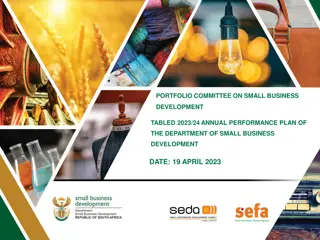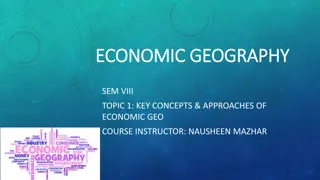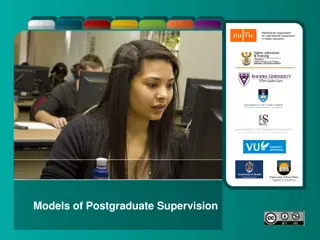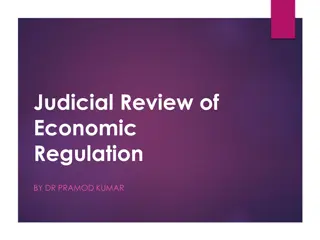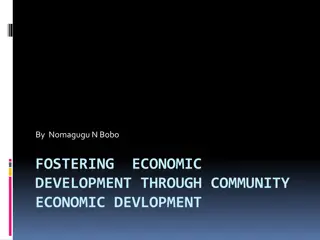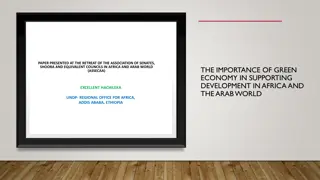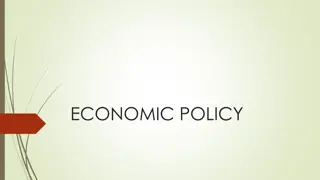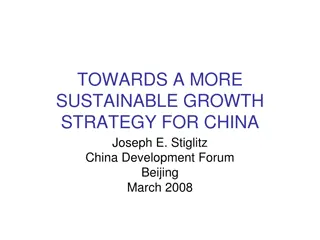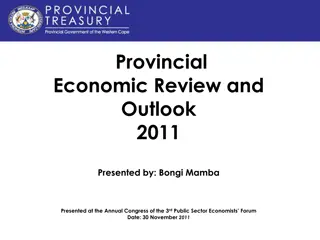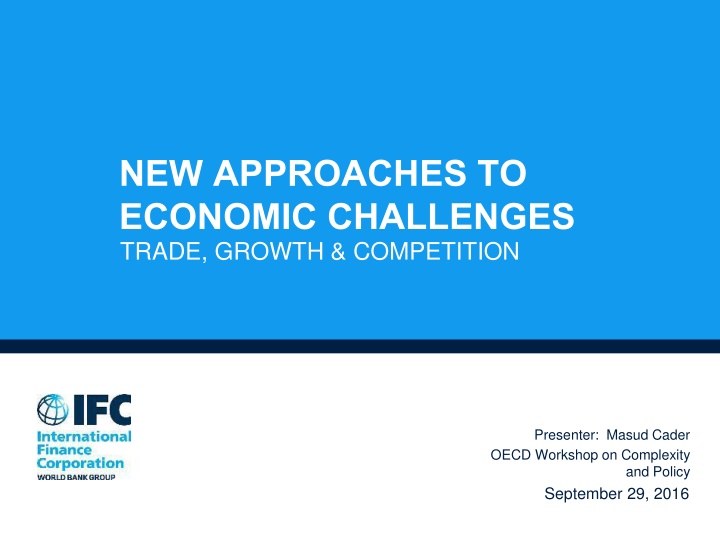
NEW APPROACHES TO ECONOMIC CHALLENGES
Masud Cader, Lead of Country Analytics at International Finance Corporation, discusses strategies integrating cross-country initiatives like One Belt One Road. With over 20 years of experience in finance and sustainable investing, Masud focuses on applying analytics to link development strategy with private sector implementation. The history of Economic Complexity at World Bank, from treasury trading strategies to sustainability networks, showcases the evolution of analyzing risks, client engagement, and product competition. Current applications of Fitness Ensemble in country strategies emphasize private sector development constraints and sector insights based on country capability and competitiveness. Explore the dynamic world of development strategy via the private sector.
Download Presentation

Please find below an Image/Link to download the presentation.
The content on the website is provided AS IS for your information and personal use only. It may not be sold, licensed, or shared on other websites without obtaining consent from the author. If you encounter any issues during the download, it is possible that the publisher has removed the file from their server.
You are allowed to download the files provided on this website for personal or commercial use, subject to the condition that they are used lawfully. All files are the property of their respective owners.
The content on the website is provided AS IS for your information and personal use only. It may not be sold, licensed, or shared on other websites without obtaining consent from the author.
E N D
Presentation Transcript
NEW APPROACHES TO ECONOMIC CHALLENGES TRADE, GROWTH & COMPETITION Presenter: Masud Cader OECD Workshop on Complexity and Policy September 29, 2016
A bit about me Masud Cader serves as the Lead of Country Analytics for the International Finance Corporation, the private sector arm of the World Bank Group. In this position Masud is responsible for strategy integration of large cross-country initiatives such as One Belt One Road, and applying analytics to create novel insights that link development strategy with private sector client implementation. Masud also co-heads the World Bank Group-IMF Economic Networks practice. He has over 20 years of experience in corporate finance, sustainable investing, investment management, equity and credit portfolio management, trading, and use of artificial intelligence to manage difficult development problems. Masud has degrees from Purdue University, American University, and Johns Hopkins University. He also teaches research courses at Georgetown University, McDonough School of Business. 1 Footer Information
Some history of Economic Complexity at World Bank 1993 - World Bank treasury trading strategies based on CAS/nonlinear dynamics 2003 Identifying seemingly unrelated risks in the business portfolio 2004 Analyzing existing sponsor/investor networks to build client engagement 2005 - Know every client in a country and estimate relationship dynamics 2007 Product competition (e.g., in pharma market: disease-treatment-api) 2011 - Identify mega trends and how they interrelate dynamically 2012 Dimensions of trade 2013 - Sustainability networks (segmentation based on sustainability) 2016 Fitness adopted for country strategy 2 Footer Information
Current Country Strategy Applications of Fitness Ensemble Identify development constraints with an emphasis on private sector across countries, and segment countries facing similar combinations of development challenges Adoption has been relatively quick, why? New analytics embedded in utility incredible focus on results and not techniques! Provide in-depth sector insights based on country capability, competitiveness and development fit Real world calibration is continuous Explore potential of service exports, and interplay between services and products into country and sector strategies Using dynamics to inform predictive models 3 Footer Information
The World is Dynamic and Development Strategy via Private Sector Should Lead the Way Ensures the flow of accurate and efficient information between people and systems Substantial productivity and export gains for SMEs Industry 4.0 Manufacturing SMEs Retail Gains in time / efficiency; Expedited production; Reduced transaction costs; Enhanced supply chains Disruptive Technology ??? ??? Sector impact Development impact Infrastructure Trade Unparalleled distribution service that broadens consumers access to: Access to Finance Health and Education Services Food Education Services Health Services Solar power -- with the potential for electricity prices to fall significantly Smart grids allow for better network connectivity enable objects to collect and exchange data (e.g. smart metering) Improves reliability and reduces costs Utilities ??? ??? Permeates all services, from basic necessities (including social safety nets), to key human rights such as health and education Agri- business Agri- business Financial Services Manufacturing Long-term trends: Artificial intelligence and robotics (also driven by computing power and data storage) in all segments of the economy including job market disruption Genomics (also driven by computing power and data storage) diagnosis and treatment Others: 3-D printing, nanotechnology drastically increases levels of automation and efficiency disruption to Agribusiness and health care, fundamental transformation of 4
What do we mean by innovation? do new things OR do things differently to create new value DO NEW THINGS A widely used external distinction*: Core An improved offering Adjacent - An offering new to a specific market Transformational A breakthrough solution DO THINGS DIFFERENTLY - also the process of innovation** CREATE NEW VALUE sustainable business and impact that can be scaled Innovation critical to help transform Billions into Trillions and create markets * Graphic from HBR: Managing Your Innovation Portfolio, Bansi Nagji and Geoff Tuff, May 2012. **Internal operational BPI excluded 5
Challenges Overcoming current economic inertia Traditional equilibrium philosophy permeates both strategy and understanding of development issues Is economic complexity too much about anticipating phase changes? Does EC only yield risk management tools? How is adoption of economic complexity accomplished? 6
Key Concepts Revealed Comparative Advantage (RCA): RCA indicates whether a country is in the process of extending the products in which it has a trade potential, as opposed to situations in which the number of products that can be competitively exported is static. It can also provide useful information about potential trade prospects with new partners. Product Progression Network: A network of different products connected by directed link which represent a causality relationship. Complexity: measure of capabilities needed to produce a product. Product requires low capability = less complex product (generally low margin, volume product) high capability = more complex product (generally higher margin, low competition, specialized) Fitness: Diversification of weighted Complexity for each Country. Measure for country s industrialization level and future prospects of growth. Density: Ease of market entry to produce a product level of possibility or proximities of the product to other products the country is already good at exporting. Growth Segmentation: Organizes 178 countries into 15 segments by similarity across projected growth/constraint profile (2009-2014) - business operation environment, economic performance, macro environment, and market potential (e.g., demographic trend of future consumers, access and nature of underserved markets). 8
The Analytical Approach in a Nutshell Product Network A network of different products connected by directed link which represent a causal relationship Based on conditional probability: if product A is produced when product B already produced, product A shares a set of capabilities with product B B A The model uses Capabilities Approach Capabilities of a country enables it to produce a given product The presence or absence of products in a country s export basket represents a hint to the capability basket of this country If many countries have Product A in their export baskets(i.e. competitively produced), such product requires low capability If only few countries have Product B in their export baskets, such product requires high capability Basket of products predict future development of competitive products in 5 years 9
Interpreting Sector Fitness radar plots Country Most complex sector Least complex sector In 2014, Croatia s normalized fitness rank in sector 333 was nearly 0.8 (compared to about 0.65 in 2000). Increasing complexity: Sector 321 is more sophisticated than 111 Red line above black line (as indicated by a bright red region): Fitness in this sector has improved between 2000 and 2014 Black line above red line: Fitness in this sector has decreased since 2000. Croatia s strength in producing these goods is diminishing. 10
Interpreting Product Progression Networks Goods in a product progression are connected by directed links which represent a causality relationship: B A Good A is usually produced after a country is able to produce good B Example progression: Higher-complexity goods are at the ends of the network Interpretation: Office machines and computers are connected, because they require similar capabilities for their production. Since this country is able to produce office machines competitively, it can also become competitive in data processing machines. Yellow nodes represent the country s non- competitive exports. Low-complexity product at the beginning of the network Green nodes are already competitively exported by the country. 11
A snapshot of what fitness means Logistics Bank Capital Adequacy Population Growth Ag Employment Tax Rates Labor Debt Service Infrastructure GVCs LT Econ Risk Science & Technology 12 Footer Information



